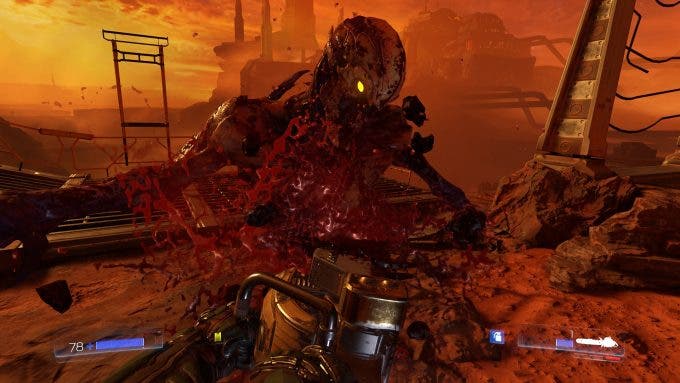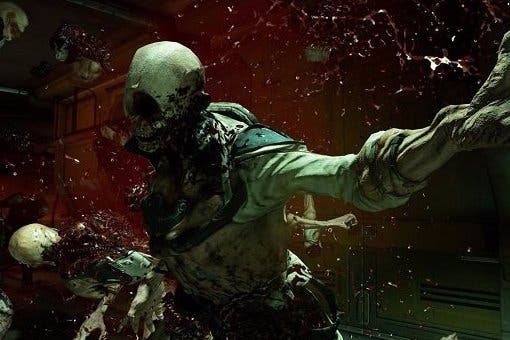Doom's new Arcade Mode is Doom at its very best
How a free update transforms a brief campaign into an endlessly enjoyable hobby.
Id Software's Doom reboot was one of 2016's most pleasant surprises. A meek marketing campaign and Bethesda's choice to not send out review copies early mired the comeback with a dose of skepticism, but thankfully the final product prevailed, mostly due to its astonishing single-player campaign. While the multiplayer and SnapMap level editor had their followers, Doom's main draw was its solo mode. As such, many were crushed when Bethesda confirmed that all of Doom's DLC would be based around the competent but unremarkable competitive multiplayer modes. But there's good news: id Software did craft new single-player content, and it's absolutely free. Even better, it's glorious.
It's not the single-player add-on you may have expected, however. Doom's fourth free update from late October doesn't add any new levels, enemies, bosses, or weapons - you know, the things people often look for in single-player DLC. Instead, id decided to tinker around with the content it already had and remixed its wonderful single-player campaign into an astonishingly good score attack Arcade Mode.
Here's how it works: each stage can be played on any difficulty with all of your power-ups unlocked. From here, you get points for killing enemies and picking up, health, armour, and score-boosting items. Consecutive kills increase a score multiplier (with a max capacity of x32) and you receive bonus points for head shots and glory kills. Each stage has a certain point-based criteria to snag bronze, silver and gold medals.
On paper, none of this sounds particularly game changing. I loved Doom, but playing through its lovingly sadistic Nightmare difficulty resulted in most stages taking 90-plus minutes to complete. My memory of such lengthy stages suggested they wouldn't gel well with the bite-sized bursts of action Arcade Mode seeks to bring. I have never been so glad to be wrong.
The reason it works is two-fold. By attaching a score multiplayer to your enemy encounters, it encourages players to race through these stages at breakneck speed. I recall the first stage taking upwards of an hour my first time through. In Arcade Mode, it took about three minutes. Three very intense minutes, to be clear.
The other way Arcade Mode manages to keep things moving is by offering players all their power-ups at the off, so there's no incentive to scavenge for hidden supplies. Your first one or two go-rounds of Doom's campaign offer a lot of downtime where the game essentially stops being a shooter and instead morphs into something of a first-person Tomb Raider or Zelda wherein you scour the scenery for secrets. If you're anything like me, you probably spent roughly a third of the game engaging in this more contemplative design. Doom's surprising emphasis on exploration added much to the game initially, but once you've found everything it becomes something of a chore to retrace your steps through these quiet moments upon subsequent playthroughs.
Doom Arcade Mode does away with downtime almost entirely. It takes what was already one of the genre's more frenetic entries and slices off all the fat.

This quick pacing is emphasised through its continue system. Where the core game let players retry indefinitely (unless they're opting for the comically challenging permadeath Ultra-Nightmare mode), Arcade Mode restricts players to a limited life system. You begin with one life, but can pick up a couple of extras strewn about the level. Lose all your chances and it's game-over. This keeps Arcade Mode sessions brief and far more palatable than the subconscious commitment that stems from embarking on a full campaign.
It's on this level that Arcade Mode immeasurably adds to the game's replay value. Having bested the game on Nightmare, there wasn't much left to do afterwards, single-player-wise, other than attempt Ultra Nightmare mode (which is too punishing to be much fun for all but the most dedicated Doom players) or replay Nightmare mode again, possibly with self-imposed restrictions. As such, Doom started collecting digital dust on my PS4 hard drive.
Arcade Mode fixes this in a big way. Now there's a tangible goal. Lots of tangible goals, in fact. Should I go for gold medals on every stage on Hurt-Me-Plenty difficulty, or aim for silvers on Nightmare? Will I have the resolve to gold star every stage on Nightmare, or dare I say, Ultra Nightmare? Probably not, but I expect to slowly pluck away at it here and there over the coming years.
After two playthroughs across 30-plus hours, I thought I was done with Doom. It turns out I was just getting started.


















